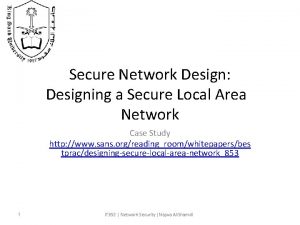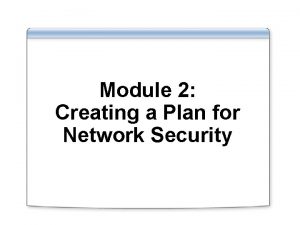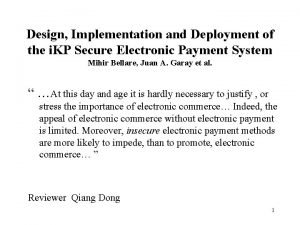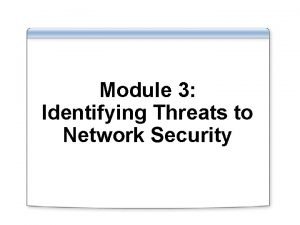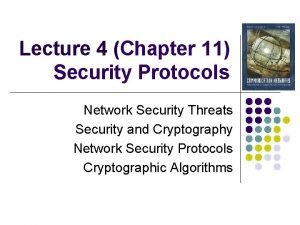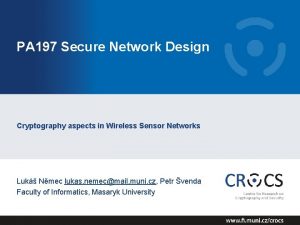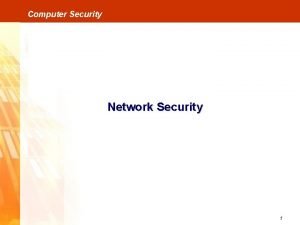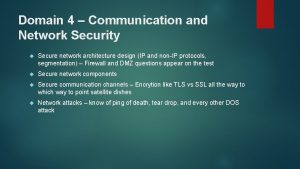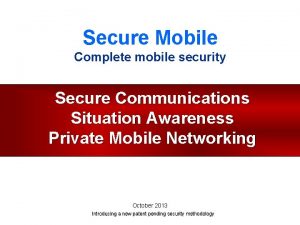PA 197 Secure Network Design Security aspects of




























![Bluetooth – versions, security features • • • BT 1. 0 [1994? ] Initial Bluetooth – versions, security features • • • BT 1. 0 [1994? ] Initial](https://slidetodoc.com/presentation_image_h2/2746b35c6a7484279fdba9de0e0f4566/image-29.jpg)




























- Slides: 57

PA 197 Secure Network Design Security aspects of wireless personal area networks (PANs) Please insert any comments, hints or spotted inaccuracies here: https: //drive. google. com/file/d/1 MCg. HENIHcd 4 g 9 y 8 Td. Istt. TSWMon. HVR 0 V /view? usp=sharing Petr Švenda svenda@fi. muni. cz Faculty of Informatics, Masaryk University

Overview • “Project” – spanning over three lectures and labs – Implementing network based on Arduino with RF module – Passive “sniffer” eavesdropping attacker – Active attacker against routing • Security considerations of wireless transmission • Technology for Personal Area Networks (PANs) – – 2 Bluetooth, NFC, Zig. Bee Design goals Security vulnerabilities Combination of technologies | PA 197 Personal Area Networks

MULTI-LAB PROJECT 3 | PA 197 Personal Area Networks

Wireless network devices • Arduino with RF module – Easy C programming – Much easier then e. g. , Tiny. OS • Every student will get node – Programming at home, homework – Cooperation with others to form basic network • Permanently running network of 20+ nodes in lab – Used for testing the attacks etc. at larger network tests – 10 -15 minutes scenarios, then reset of the network 4 | PA 197 Personal Area Networks

Wireless network project • Implementation of ad-hoc network based on Arduino with RF module • Larger “project” spanning over next three weeks – Labs & Homework • Laboratory 9: initial implementation of reliable packet transmissions and neighbor discovery, eavesdropping • Laboratory 10: parsing routing info, actively manipulating routing information • Laboratory XX: Pairwise and probabilistic key distribution and secure channel – Not this year, partially covered in previous two labs 5 | PA 197 Personal Area Networks

What to prepare for labs • Download and install Arduino software in advance! – https: //www. arduino. cc/en/Main/Software • Read Arduino development guide (L. Nemec) – Uploaded in IS, labs folder • Collect Jee. Nodes today or during Wednesday labs – Please don’t forget to sign the sheet! 6 | PA 197 Personal Area Networks

7 | PA 197 Personal Area Networks

PERSONAL AREA NETWORKS 8 | PA 197 Personal Area Networks

Main design goals • (Not necessary all at the same time) 1. Energy efficiency – Running long time only on batteries 2. Physical locality of communication (NFC) – Imposing restrictions on attacker 3. Quick establishment of temporary connections – Usable security 4. Ad-hoc networking – Temporary networks without pre-fixed structure 9 | PA 197 Personal Area Networks

Basic steps of communication 1. Discover other device(s) – Public broadcast vs. private sharing 2. Authenticate and establish initial key(s) (pairing) – Usually once for new devices 3. Authenticate and refresh keys for paired devices – If long-term persistence is maintained (known devices) 4. Exchange packets between devices 5. Terminate connection 10 | PA 197 Personal Area Networks

Wireless networks WIRELESS MEDIUM - ATTACKS 11 | PA 197 Personal Area Networks

Attack surface is large • Wireless signal propagates more easily – Eavesdropping, message injection – Also more difficult to localize attacker • Processing transmissions more complicated – Potential for bugs in implementation, network stack • Potential for physical device compromise – Device not connected => easier to be lost/stolen… 12 | PA 197 Personal Area Networks

Wireless medium – basic properties • Eavesdropping on active transmission is easy – Omnidirectional vs. directional antenna – Active vs. passive communication mode • Eavesdropping on passive device (RFID, ISO 14443) more difficult (passive mode) – Tag/card does not emit signal on its own – Tag/card specifically distorts EM field measured by reader • Multiple channels may require multi-channel eavesdropping – Frequency hopping based on secret sequence (PRNG) 13 | PA 197 Personal Area Networks

Generic attacks: Eavesdropping • Active active transmission – Directional antenna, e. g. , Bluetooth 102 104 meters • Active passive transmission – Tens of meters for active signals (reader tag), easy – Up to 1 m for passive signals (tag reader), difficult • Signals must be reliable enough for normal communication => stronger than necessary minimum • Eavesdropping cannot be generally prevented – Possibly only significantly limited in distance (NFC) • Solution: use secure channels (encryption, auth) 14 | PA 197 Personal Area Networks

Attack: record and compromise later • Eavesdropped communication is encrypted • Used key is later recovered by other means – End-node compromise, side-channel attack, bruteforce… – => Past communication can be decrypted (later) • How to prevent? – (Perfect) forward secrecy protocols (e. g. , ECDH) 15 | PA 197 Personal Area Networks

Generic attacks: data corruption • Attacker tries to corrupt data during transmission – Channel level: additional transmission jamming – Link/tunnel level: sinkhole, dropper… • Form of denial-of-service • Broad vs. selective jamming – Broad jamming requires higher power of transmission – Selective jamming corrupts only few bits in header / packets • Solution: device detects and verifies signal strength, counts transmitted/dropped packets… – But signal naturally fluctuates => harder to detect attack 18 | PA 197 Personal Area Networks

Generic attacks: Man-in-the-middle • Third device acts as relay between two legitimate devices – Log/block/modify communication – Emulates perception of close presence (door lock, card payment) • If mounted against active-active communication mode – Attacker can be farther away – Possibly needs to block legitimate traffic (to legitimate party) • If mounted in active-passive mode – Attacker needs to be closer to victim (passive active) • May require low-latency relaying on attackers side • Potential defense: distance bounding protocols 19 | PA 197 Personal Area Networks

Example: Passive wired relay • • No amplifier or other active components required Coaxial cable between two antennas, 20 metres or more Very low delay (practically not detectable) Low cost http: //cdn. intechopen. com/pdfs-wm/44973. pdf 20 | PA 197 Personal Area Networks

Example: e. Passport simulator Proxmark III (M. Korec) https: //is. muni. cz/auth/th/396490/fi_b/ 21 | PA 197 Personal Area Networks

Distance bounding protocols • Enable verifying device to establish upper bound on physical distance from connecting device – Time to receive response to challenge is measured – Multiplied by speed of light (~RF waves speed) • Problem: transmission time may be significantly smaller than necessary processing time – Especially for high-frequency channels – Important to measure precisely 1 ns => 15 cm error • More likely to detect active Mit. M than passive relay • http: //cdn. intechopen. com/pdfs-wm/44973. pdf 22 | PA 197 Personal Area Networks

Wireless networks - Bluetooth BLUETOOTH 23 | PA 197 Personal Area Networks

Bluetooth – basic information • Wireless standard for exchanging data over short distances – IEEE 802. 15. 1 standard (no longer maintained) – Specification maintained by Bluetooth Special Interest Group (SIG) • UHF radio waves in the ISM band from 2. 4 to 2. 485 GHz (globally unlicensed band, scientific and medical) – Frequency-hopping spread spectrum (1600 hops/sec), Adaptive Frequency -Hopping (AFH, avoids crowded frequencies) – 79 designated Bluetooth 1 MHz channels (40 for BT 4. x) • Class 1/2/3 devices (max. power, distance ~100/10/1 m) • Speed 1 Mbit – 24 Mbit / sec • Bluetooth usage profiles (https: //en. wikipedia. org/wiki/List_of_Bluetooth_profiles) 24 | PA 197 Personal Area Networks

Bluetooth - networking • Each BT device has unique 48 -bit device address • Discoverable vs. hidden mode – On demand response (device name, class, services, info) – If discoverable then always respond – If hidden then respond only if other device address is already known • Packet-based protocol with master-slave order – One master up to 7 slaves (forms piconet) – Even and odd medium slots for master/slave transmission • Multiple piconets form scatternet – Some devices both master in piconet X and slave in piconet Y – Extends device range via multi-hop communication – (Not really used in practice so far) 25 | PA 197 Personal Area Networks

Bluetooth – piconets, scatternet http: //csrc. nist. gov/publications/nistpubs/800 -121 -rev 1/sp 800 -121_rev 1. pdf 26 | PA 197 Personal Area Networks

Bluetooth vs. Wi. Fi • AP-based Wi. Fi is asymmetric (infrastructure) – BT is master – slave, but usually ad-hoc • BT generally requires less configuration • BT is more power efficient, especially BT 4. x LE • AP-based Wi. Fi is generally more suitable for infrastructural placement, BT for ad-hoc networking • Cooperation of technologies – Initial pairing setup via BT, fast transmission via Wi. Fi 27 | PA 197 Personal Area Networks

PA 197 - PANs, Bluetooth struktury 28 | PA 197 Personal Area Networks

Wireless networks - Bluetooth BLUETOOTH SECURITY 29 | PA 197 Personal Area Networks

Security requirements • What would you like to have? • NIST guidelines to Bluetooth security – https: //nvlpubs. nist. gov/nistpubs/Special. Publications/NIST. SP. 800 -121 r 2. pdf 30 | PA 197 Personal Area Networks
![Bluetooth versions security features BT 1 0 1994 Initial Bluetooth – versions, security features • • • BT 1. 0 [1994? ] Initial](https://slidetodoc.com/presentation_image_h2/2746b35c6a7484279fdba9de0e0f4566/image-29.jpg)
Bluetooth – versions, security features • • • BT 1. 0 [1994? ] Initial version, mandatory encryption BT 1. 1 [2002] Possibility for non-encrypted channels BT 2. 1 [2007] Secure simple pairing (SSP) BT 3. 0 [2009] Negotiation of high speed over 802. 11 link BT 4. 0 [2010] BT low energy (Wibree), coin cell power, Bluetooth Smart Ready, SSP not available • BT 4. 2 [2014] Introduces important features for Io. T, LE Secure Connections, Link Layer Privacy, ECDH-based SPP • BT 5 [2016] Larger range and transmission speed • BT 5. 1 [2019] Angle of Arrival/Departure (tracking devices), broadcast data without full connection (e. g. , thermometer) 31 | PA 197 Personal Area Networks

Bluetooth security modes • Mode 1 provides no security – Any device can connect, no encryption – Up to Bluetooth 2. 0 + Enhanced Data Rate (EDR) and NOT beyond • Mode 2 provides security at the service level – After a communication channel is established – Centralized security manager controls • Mode 3 provides security at the link level – Before a logical channel is established – Authentication and encryption of all connections – Decreases attack surface, but requires key predistribution • Mode 4 provides Secure Simple Pairing – Connects two previously unpaired devices (DH, ECDH) 32 | PA 197 Personal Area Networks

Bluetooth – crypto algorithms used • SAFER+ block cipher – used as building block for key derivation, authentication • E 0 stream cipher for encryption – Encryption key, master device BT address, real-time clock • E 22 key derivation algorithm – Derive initial key from address, rand PIN • BT < 4. 0 E 21 session key derivation algorithm – Link key generation from initial key • E 1 authentication algorithm – Authenticate devices after pairing • AES cipher in Counter mode (AES-CCM) – Introduced for Bluetooth LE (BT 4. 0) BT >= 4. 0 • General trend: used to be custom crypto (earlier, < 4. 0), move towards standard primitives (now, >= 4. 0) 33 | PA 197 Personal Area Networks

Bluetooth attacks • Bluesnarfing, Bluebugging – Unauthorized extraction of data from device (discoverable mode) • Guessing device address via brute-force attack – 48 bit MAC address, but first 24 as manufacture’s id • Limited key-usage period (< BT 2. 1) – Around 23. 5 hours before simple XOR attack (E 0 stream cipher) • Encryption can be forced to be turned off (< BT 2. 1) • L 2 CAP level attacks – Parts of data packet not protected by integrity – Fuzzing used to find flaws in device’s firmware 39 | PA 197 Personal Area Networks

DH based on elliptic curves used (ECDH) EC curve, G (base point) Bx. G A x G (scalar multiplication) Ax. Bx. G Axb Bxa Ax. Bx. G http: //www. themccallums. org/nathaniel/2014/10/27/authenticated-key-exchange-with-speke-or-dh-eke/ 41 | PA 197 Personal Area Networks

BT Pairing – Secure Simple Pairing (SSP) • Secure Simple Pairing (SSP, from BT 2. 1) – Public-key crypto based (ECDH from BT 4. 2) for key agreement • How to authenticate ECDH public part? – – Just works mode: no authentication Numeric comparison mode: display challenge and confirm Passkey Entry mode: insert passphrase Out Of Band mode: use other channel to establish auth. key • 128 bit random link key for encryption (at maximum) – Length negotiated by devices 42 | PA 197 Personal Area Networks

SSP Just works / Numeric comparison / Pass Key Entry / Out of Band… 43 https: //nvlpubs. nist. gov/nistpubs/Special. Publications/NIST. SP. 800 -121 r 2. pdf | PA 197 Personal Area Networks

Bluetooth LE/Smart (BT 4. x) (2010) • For low-energy, storage/computation restricted devices • Simplified protocol for link key establishment – LE pairing protocol establish long-term key (LTK) – Key transport instead of key agreement is used – One device generates LTK and transports during pairing • What are the security implications? • Support for out-of-band for pairing – E. g. , NFC-based exchange of Temporary Key (TK) • AES-CCM introduced (relevant for FIPS 140 -2) • Introduction of private device address – Public device address from encrypted (changing) private address – Eavesdropper will not learn public address => no address tracking 44 | PA 197 Personal Area Networks

Bluetooth LE/Smart (BT 4. 0) • BT Secure Simple Pairing uses Diffie-Hellman – To prevent passive eavesdropping and forward secrecy – But asymmetric crypto is slow(er) + energy consuming • Design decision for 4. 0 – no SSP at the time – BT 4. 0 LE/Smart pairing is symmetric-cryptography based – Passive eavesdropping + delayed key compromise possible • BT LE pairing with ECDH keys added in BT 4. 2 – Authenticated ECDH exchange of link key 45 | PA 197 Personal Area Networks

Bluetooth – Tracking privacy • Each BT device has unique 48 -bit device address – BT 1. 0 required mandatory transmission, later dropped • Discoverable / non-discoverable mode – Once discoverable, device’s address is trackable – Address space (48 b, manufacturer) can be brute-forced • BT 4. 0 (BT LE) allows for private device address – Public device address (used in key establishment) broadcasted only in encrypted form – Eavesdropper cannot track target device based on MAC 46 | PA 197 Personal Area Networks

Bluetooth – (moral) summary • One of early protocols intended for battery-powered “limited” devices (BT 1. x) – Cell phones that time, wireless headsets… – Vulnerabilities due to insecure defaults, proprietary crypto etc. – Typical for the period of its introduction (recall also Wi. Fi’s WEP…) • More security features introduced (BT 2. x) – But also usability, adoption and intellectual property dispute issues • Cooperation with other technologies, speed (BT 3. x) – Initial exchange and configuration, then faster Wi. Fi transmissions • Added focus on extra low energy devices (BT 4. x) – Secure by default, standardized crypto algorithms – Renewed interest and support, wider adoption 48 | PA 197 Personal Area Networks

Wireless networks – Near Field Communication NFC 49 | PA 197 Personal Area Networks

Near Field Communication (NFC) • Low-power, low-bandwidth communication – Initially for reader to tag communication – Possibility for tag emulation by device (=>device to device) • Be aware of potential confusion of “NFC” term 1. As general term (short distance communication) 2. As NFC as specific implementation (NFC A, ISO 18092) 50 | PA 197 Personal Area Networks

NFC standards "NFC Protocol Stack" by Erik Hubers – Licensed under CC BY-SA 4. 0 via Commons 51 | PA 197 Personal Area Networks

Security goals of NFC 1. Physical presence proof – Only short distance communication possible – Locality of eavesdropping 2. Simplify key management for other protocols (OOB) – Uses physical presence proof – NFC initial key BT SSP BT/Wi. Fi transmission – NFC IP, MAC, key Wi. Fi-Direct 3. Utilize secure hardware via NFC reader – Physical tag, token, cryptographic smart card… 4. Turn mobile phone into security token – Card emulation 52 | PA 197 Personal Area Networks

NFC communication modes 1. Reader/writer mode – Read (and/or write) NFC tags and stickers – No security except physical presence bounding – Usually only tag’s/sticker’s ID transmitted 2. P 2 P mode – exchange data with other NFC peer – used by Android Beam between two NFC-enabled phones 3. Card emulation – NFC device emulates tag/cryptographic smart card 53 | PA 197 Personal Area Networks

NFC mode: Card emulation • NFC device emulates tag/cryptographic smart card 1. Card emulation mode – NFC device acts as NFC card – Emulated by separate chip in device – secure element • Commands are relayed to real card 2. Host-based card emulation – Emulation without physical secure element – Phone provides functionality of smart card • Software “smart card” – Apple Pay, Android Pay… 54 | PA 197 Personal Area Networks

NFC as bootstrapping technology • Out Of Band (OOB) exchange of initial secrets – Utilizes “physical” presence property of NFC – Simplifies initial key exchange • dependency on difficulty of eavesdropping/Mit. M • Android Beam – Uses NFC to exchange 6 -digits passcode for Bluetooth • Samsung S-Beam – IP, MAC via NFC for Wi. Fi-Direct • … 55 | PA 197 Personal Area Networks

NFC security (NFC-SEC, NFC-SEC-01) • “Shared Secret Service” (SSE) – Results in confirmed shared key between devices – Based on Elliptic Curve Diffie-Hellman key exchange scheme (ECDH-192 b) – Not authenticated (Mi. TM possible, but physical location) • "Secure Channel Service" (SCH) – Results in link key for secure channel derived from SSE – Uses AES and AES-CRT for key derivation, encryption, integrity • Application-level security possible – Use NFC to exchange keys for Bluetooth/Wi. Fi – Implement custom protocol between devices (if needed) • • 56 http: //www. ecma-international. org/publications/files/ECMA-ST/ECMA-386. pdf http: //www. ecma-international. org/publications/files/ECMA-ST/ECMA-385. pdf | PA 197 Personal Area Networks

NFC vs. Bluetooth • NFC consumes significantly less energy • NFC has significantly shorter maximum distance – Active passive mode, advantage of physical bounding • NFC is compatible with existing standards/devices – Passive RFID • Bluetooth LE moved more towards energy-efficiency – But still only active-active mode 58 | PA 197 Personal Area Networks

Wireless networks – Moving towards more networking ZIGBEE (IEEE 802. 15. 4) 59 | PA 197 Personal Area Networks

Zig. Bee – characteristics • Standardized as IEEE 802. 15. 4 – Zig. Bee Alliance maintains current version – Niche between Bluetooth and Wi. Fi • Low cost, low power, mesh networking – Low power transmissions, smaller bitrate (250 kbit/s) – 10 -100 meters (active-active communication mode) – Focus on sensors and control automation • Various radio bands (2. 4 GHz), routing specifications • Supports star, tree and mesh network topology – E. g. , wireless sensor networks, up to 65000 nodes 60 | PA 197 Personal Area Networks

Zig. Bee network • Zig. Bee Coordinator (ZC) / PAN coordinator – One coordinator per network – Responsible for establishment of network – Serve as repository for security keys • Zig. Bee Router (ZR) / Coordinator – Pass data from one node to another (routing scheme) – Intermediate node in network • Zig. Bee End Device (ZED) / Network device – Cheaper to produce, end (sensor) node – Cannot relay communication => can sleep => battery life 61 | PA 197 Personal Area Networks

Joining Zig. Bee network 62 Source: https: //docs. zigbee. org/zigbee-docs/dcn/09 -5378. pdf | PA 197 Personal Area Networks

Zig. Bee keys 1. Pre-installation of master keys – Network key (shared by all), Link key (between 2 devices) 2. Transport of link keys – Trust center (ZC) sends link key to both nodes 3. Certificate-based key establishment – Trust center (ZC) facilitate establishment, no keys send between device and ZC – Elliptic Curve MQV key agreement scheme 63 | PA 197 Personal Area Networks

Zig. Bee cryptography • Mostly based on symmetric cryptography – AES with 128 b keys, master key, link key, network key(s) – Uses AES-CCM* mode for link layer encryption • encryption/integrity-only mode possible, MAC 4 bytes • Certificate-based key establishment – Elliptic Curve MQV key agreement scheme – Requires certification authority 64 | PA 197 Personal Area Networks

SUMMARY 65 | PA 197 Personal Area Networks

Comparison: BT/NFC/Zig. Bee • • • BT initially not for low-energy, but adapted (BT 4. x) NFC uses active-passive mode (locality) Pre-distributed keys vs. user interaction vs. locality Zig. Bee towards mesh networks Bluetooth LE also in direction of mesh networks • (Next lecture will focus more on WSNs) 66 | PA 197 Personal Area Networks

Similarity between protocols (security) • • 67 Easy eavesdropping Usage of proprietary (weak) ciphers (at beginning) Incorrect implementations of (complicated) standard Reuse of key stream (“never” need 220 packets? ) Problem of initial pairing (how to authenticate? ) Brute-forcing usable/memorable/short PINs Problem of device tracking (unique device ID) Security generally getting better over time | PA 197 Personal Area Networks
 Designing a secure network
Designing a secure network Security private
Security private Osi security architecture in network security
Osi security architecture in network security Security guide to network security fundamentals
Security guide to network security fundamentals Wireless security in cryptography and network security
Wireless security in cryptography and network security Electronic mail security in network security
Electronic mail security in network security Security guide to network security fundamentals
Security guide to network security fundamentals Security guide to network security fundamentals
Security guide to network security fundamentals Ethical and professional issues in information security
Ethical and professional issues in information security Security aspects
Security aspects Network security design and implementation
Network security design and implementation Top-down network design
Top-down network design Planning phase for network security design
Planning phase for network security design Firewall design principles in network security
Firewall design principles in network security Secure socket layer and transport layer security
Secure socket layer and transport layer security Secure socket layer and transport layer security
Secure socket layer and transport layer security Secure socket layer and transport layer security
Secure socket layer and transport layer security Secure socket layer and transport layer security
Secure socket layer and transport layer security Ece 526
Ece 526 Artoghrol 197
Artoghrol 197 Jumlah molekul dalam 0,5 mol emas adalah
Jumlah molekul dalam 0,5 mol emas adalah Lirik nkb 197
Lirik nkb 197 Iso 26142
Iso 26142 Cse 197
Cse 197 Articulo 122 lottt
Articulo 122 lottt Au-197=50 au 198=50
Au-197=50 au 198=50 Au-197=50 au 198=50
Au-197=50 au 198=50 Bisp 197
Bisp 197 Nkb 176
Nkb 176 Tf clause
Tf clause Samjaen
Samjaen Tuhanku yesus
Tuhanku yesus Nkb 197
Nkb 197 Nkb 197
Nkb 197 Cs 197
Cs 197 Juniper atp appliance
Juniper atp appliance Junos network secure
Junos network secure Secure network gateway
Secure network gateway The recurring aspects of designs are called design
The recurring aspects of designs are called design The recurring aspects of designs are called design
The recurring aspects of designs are called design The recurring aspects of designs are called design
The recurring aspects of designs are called design Secure design patterns
Secure design patterns Secure design patterns
Secure design patterns I kp
I kp Explain about visa international security mode
Explain about visa international security mode Nstissc security model
Nstissc security model E commerce security policy
E commerce security policy Software security touchpoints
Software security touchpoints Nist frame
Nist frame Wlan network
Wlan network Pcnse certificate
Pcnse certificate Network security protocols
Network security protocols Network security essentials 5th edition pdf
Network security essentials 5th edition pdf Intruders in network security
Intruders in network security Module 3: information and network security
Module 3: information and network security Message authentication is not concerned with
Message authentication is not concerned with Playfair cipher
Playfair cipher Network security monitoring tools open source
Network security monitoring tools open source
